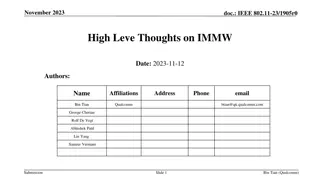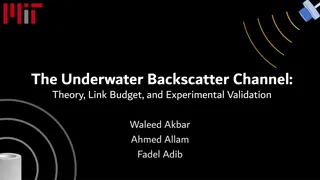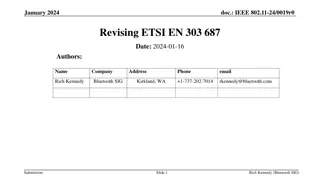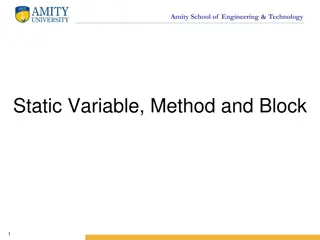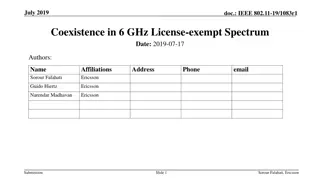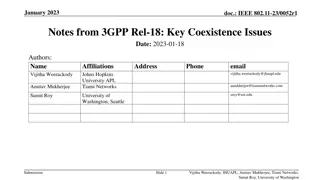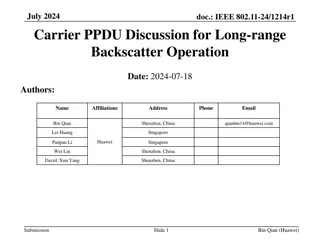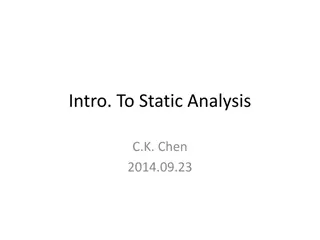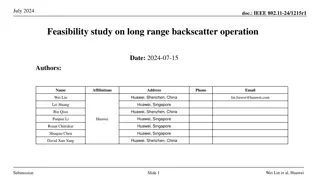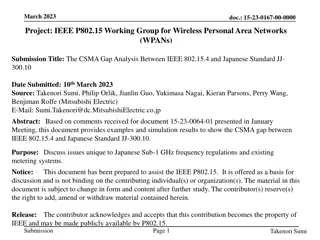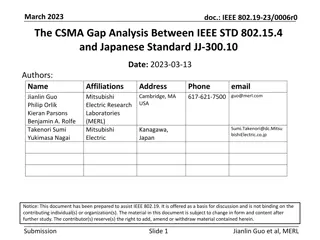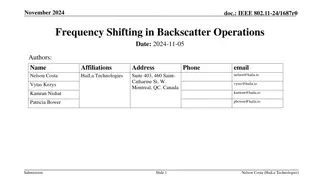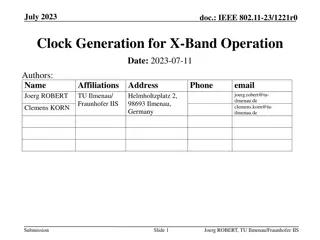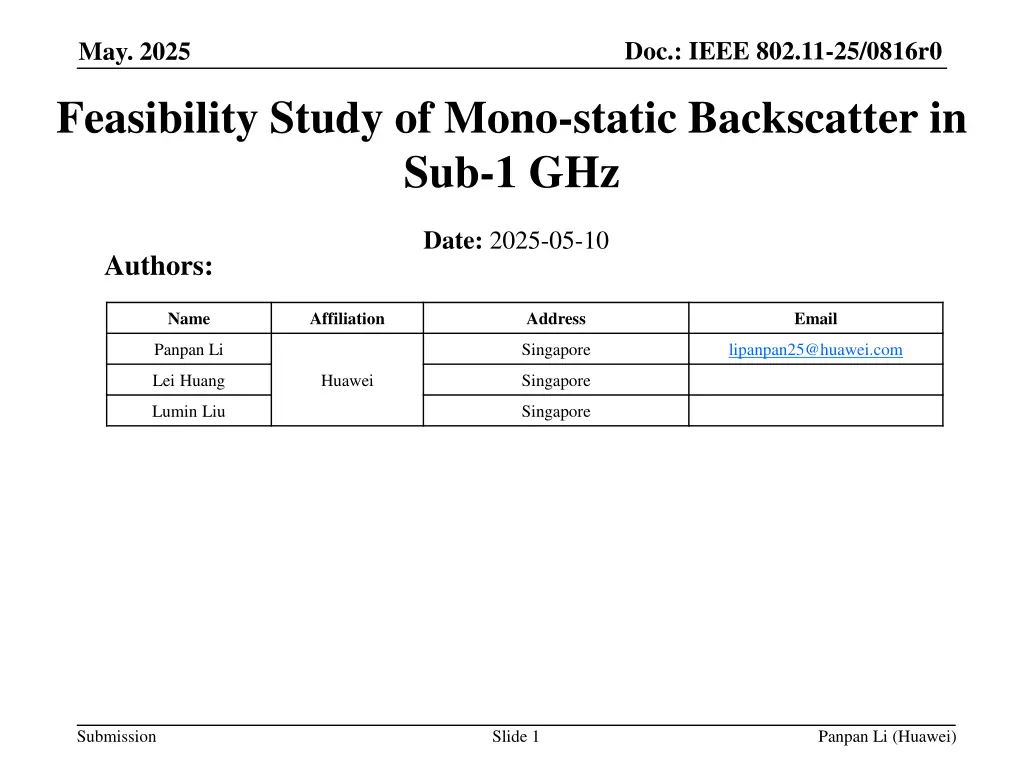
Feasibility Study of Mono-static Backscatter Communication in Sub-1 GHz Band
This document explores the feasibility of mono-static backscatter communication in the sub-1 GHz frequency range for various use cases such as AMP S1G tag reading, self-jammer cancellation, and RF carrier cancellation. It discusses the background, operating bands, link budget analysis, and coexistence issues related to this communication method. The study also delves into the potential use cases and technical aspects of achieving over 5 meters of coverage, including RF harvesting and power management. Additionally, it examines prior arts of self-jammer cancellation, RF carrier cancellation techniques, and circuit examples for achieving substantial signal suppression in UHF RFID applications.
Download Presentation

Please find below an Image/Link to download the presentation.
The content on the website is provided AS IS for your information and personal use only. It may not be sold, licensed, or shared on other websites without obtaining consent from the author. If you encounter any issues during the download, it is possible that the publisher has removed the file from their server.
You are allowed to download the files provided on this website for personal or commercial use, subject to the condition that they are used lawfully. All files are the property of their respective owners.
The content on the website is provided AS IS for your information and personal use only. It may not be sold, licensed, or shared on other websites without obtaining consent from the author.
E N D
Presentation Transcript
Doc.: IEEE 802.11-25/0816r0 May. 2025 Feasibility Study of Mono-static Backscatter in Sub-1 GHz Date: 2025-05-10 Authors: Name Affiliation Address Email Panpan Li Singapore lipanpan25@huawei.com Lei Huang Huawei Singapore Lumin Liu Singapore Submission Slide 1 Panpan Li (Huawei)
Doc.: IEEE 802.11-25/0816r0 May. 2025 Background This contribution intends to discuss the feasibility of mono-static backscattering communication in sub-1 GHz Use cases AMP S1G tag reading Prior arts of self-jammer cancellation Link budget analysis Operating bands, bandwidth PHY design principle Coexistence issues Submission Slide 2 Panpan Li (Huawei)
Doc.: IEEE 802.11-25/0816r0 May. 2025 Use cases According to AMP technical report, some mobile device related use cases like item tracking and smart home require coverage up to 10 meters [2]. Mobile device related mono-static backscattering use cases in 2.4 GHz discussed in [3] has coverage 10~20cm. Mono-static backscattering communication in sub-1GHz is expected to achieve >5m coverage. Submission Slide 3 Panpan Li (Huawei)
Doc.: IEEE 802.11-25/0816r0 May. 2025 AMP S1G Tag reading Directional coupler/Circulator RF carrier cancellation Carrier ADC Rx RF Harvesting & Power Management Digital Logic Baseband leakage removal Rx OOK signal Tx Tx AMP AP Single antenna Leakage removal modules RF carrier cancellation (including directional coupler/circulator) Baseband leakage removal AMP tag Similar simple tag as 2.4G Submission Slide 4 Panpan Li (Huawei)
Doc.: IEEE 802.11-25/0816r0 May. 2025 Prior Arts of self-jammer cancellation Typical RF carrier cancellation in UHF RFID achieve 50-70dB [5] Baseband algorithm can bring >60dB (up to 80dB) suppression [6, 7] RFID chips [8-11] achieve [-103, -77]dBm Rx sensitivity 10dBm self-jammer at Rx port is usually assumed Assume backscatter signal -90dBm, >100 dB self jammer cancellation are achieved Tx power (dBm) Rx sensitivity (dBm) [8] 33, 11 -103, -98, -93, -84 [9,11] 30, 17.5 -80, -77 [10] 33, 27, 11 -88, -82, -75 Submission Slide 5 Panpan Li (Huawei)
Doc.: IEEE 802.11-25/0816r0 May. 2025 RF carrier cancellation circuit examples in [8-11] Submission Slide 6 Panpan Li (Huawei)
Doc.: IEEE 802.11-25/0816r0 May. 2025 Link budget analysis Pt_AP=35dBm Antenna loss: -5dB Return loss: 15dB 5m PL: -45.7dB Coupling: -10dB Backscatter loss: -5dB Leakage before removal: 10dBm 5m PL: -45.7dB Antenna loss: -5dB Backscatter signal: -81.4dBm Coupling: -10dB 95dB Leakage after removal: -85dBm Thermal noise: - 114dBm (1MHz) ? SINR= ?+?>3dB We need to mitigate leakage to at least -85dBm (~95dB suppression), which should be achievable for very narrow band signal (e.g., CW) RF carrier cancellation (45dB) Baseband interference suppression (50dB) Submission Slide 7 Panpan Li (Huawei)
Doc.: IEEE 802.11-25/0816r0 May. 2025 Operating bands, bandwidth To achieve >5m coverage in sub-1GHz, AMP may seek operating bands with higher Tx power. Possible AMP operating bands in sub-1GHz [Appendix A]: For US, comply with FCC For China, RFID bands For EU: maybe RFID bands For other areas, choose operating bands with higher Tx power limitation Possible AMP BW in sub-1GHz: 200 kHz , 400 kHz, 250 kHz, 500 kHz,... Submission Slide 8 Panpan Li (Huawei)
Doc.: IEEE 802.11-25/0816r0 May. 2025 PHY design general principle AMP-S1G PHY should be consistent with 2.4 GHz as much as possible Device type: mono-static backscatter, bi-static backscatter, active transmission PPDU format: overall formats remain same with 2.4G, details maybe different Modulation: OOK is baseline Coding: start with Manchester, open to other choices Focus on difference of AMP PHY operating on sub-1 GHz and 2.4G Operating class, bandwidth, channelization Data rates: limited by BW Waveform: start with CW, since narrow BWs make DSSS/OFDM/MC-OOK not suitable Submission Slide 9 Panpan Li (Huawei)
Doc.: IEEE 802.11-25/0816r0 May. 2025 AMP-S1G PPDUs AMP-S1G DL PPDU Backscatter: (S1G preamble) + Excitation + AMP-Sync + (AMP-SIG) + AMP-Data + Excitation The existence of S1G preamble depends on regions S1G preamble can be changed based on S1G_1M PPDU (11ah) could exist repetitions of AMP-Sync + (AMP-SIG) + AMP-Data + Excitation Non-backscatter: (S1G preamble) + AMP-Sync + (AMP-SIG) + AMP-Data AMP-S1G UL PPDU AMP-Sync + AMP-Data S1G preamble Excitat ion AMP- Sync AMP- SIG AMP- Data Excitat ion . AMP- Sync AMP- SIG AMP- Data UL PPDU DL PPDU Submission Slide 10 Panpan Li (Huawei)
Doc.: IEEE 802.11-25/0816r0 May. 2025 Coexistence Level 1: 802.11 & non 802.11 [2] Energy detection, LBT, Level 2: 11bp & 11ah 11ah devices are expected to recognize AMP-S1G PPDUs S1G preamble in AMP-S1G PPDUs can be constructed based on 11ah preamble Level 3: AMP data communication in sub-1 GHz & AMP WPT First need to decide whether WPT PPDU should be designed and distinguished Also, interference from 2.4 GHz may be considered. Data communication AMP WPT 802.11 11ah Coex issues Energy detection, LBT Non 802.11: RFID, etc Submission Slide 11 Panpan Li (Huawei)
Doc.: IEEE 802.11-25/0816r0 May. 2025 Summary In this contribution, we investigated the feasibility of mono-static backscattering communication in sub-1 GHz. According to the evaluations, it is feasible to achieve >5 meter coverage with High Tx power RF and baseband self-jammer cancellation Submission Slide 12 Panpan Li (Huawei)
Doc.: IEEE 802.11-25/0816r0 May. 2025 Reference [1] 11-25-0338-00-00bp-amp-data-communication-in-sub-1-ghz [2] 111-23-2203-01-0amp-updated-technical-report-on-support-of-amp-iot-devices-in-wlan [3] 11-23-2038-01-0amp-close-range-amp-backscattering-in-2-4ghz [4] https://www.digikey.com/en/products/filter/rf-circulators-and-isolators/1010 [5] https://ieeexplore.ieee.org/stamp/stamp.jsp?tp=&arnumber=9418696 [6] https://ieeexplore.ieee.org/stamp/stamp.jsp?tp=&arnumber=9380725 [7] Q. Guo et al., A novel adaptive leakage suppression method for UHF RFID reader, in Proc. IEEE Int. Conf. RFID (RFID), May 2017, pp. 187 192. [8] https://support.impinj.com/hc/article_attachments/40267970973459 [9] https://www.st.com/resource/en/data_brief/st25ru3993-hpev.pdf [10]https://www.cisper.com/datasheets/MTI%20Micro%20Electronics/MTI_Micro_Electronics_MSx1 0_RFID_Reader_SiP_Datasheet_v1.2a.pdf [11] https://www.st.com/resource/en/application_note/an5532-carrier-cancellation-for-rain-rfid- readers-with-st25ru3993-stmicroelectronics.pdf Submission Slide 13 Panpan Li (Huawei)
Doc.: IEEE 802.11-25/0816r0 May. 2025 SP 1 Do you agree to add the following text to TG bp SFD? 11bp defines at least one mode of MAC/PHY that supports mono-static backscattering communication in sub-1 GHz. Yes No Abstain Submission Slide 14 Panpan Li (Huawei)
Doc.: IEEE 802.11-25/0816r0 May. 2025 Appendix Except the table below, other regulations [iv] may also be considered. China [i] Europe [ii] US [iii] RFID RFID Frequency hopping spread spectrum Digital modulated systems Bands (MHz) 840-845, 920-925 865-868 915-921 902-928 Bandwidth 250 kHz 200 kHz 400 kHz TX power 2W (ERP) 2W (ERP) 4W (ERP) >=50 channel: 36 dBm (EIRP) <50 channel: 30 dBm (EIRP) 36 dBm (EIRP); <=8 dBm in any 3 kHz Transmit mask Adjacent Channel Power Ratio (ACPR): 40dB (first adjacent channel), 60 dB (second adjacent channel) Channel<250kHz, at least 50 channels; Channel>250kHz, at least 25 channels; Maximum allowed 20dB bandwidth is 500kHz minimum 6 dB bandwidth shall be at least 500 kHz [i] 800/900MHz RFID . [ii] https://www.etsi.org/deliver/etsi_en/302200_302299/302208/03.04.01_60/en_302208v030401p.pdf. [iii] https://www.law.cornell.edu/cfr/text/47/15.247. [iv] https://www.itu.int/dms_pubrec/itu-r/rec/sm/R-REC-SM.2151-0-202209-I!!PDF-E.pdf Submission Slide 15 Panpan Li (Huawei)
Doc.: IEEE 802.11-25/0816r0 May. 2025 Appendix : Simulation results DL PER of data field Simulation setting: TX Channel RX Payload: 100 bits Encoding: Manchester Modulation: OOK Waveform: CW No Tx filter AWGN channel No Rx filter Non-coherent detector Submission Slide 16 Panpan Li (Huawei)
Doc.: IEEE 802.11-25/0816r0 May. 2025 Appendix : Simulation results UL PER of data field Leakage AP STA d Simulation setting: AP side: Packet size = 100 bits Manchester encoding EIRP: 35dBm (0dBr) Leakage : modeled in Rx noise Rx noise: -55dBm (-90dBr) No filter Coherent detector STA side: Modulation noise: -20dBr Backscatter loss: 5dB No filter Submission Slide 17 Panpan Li (Huawei)


